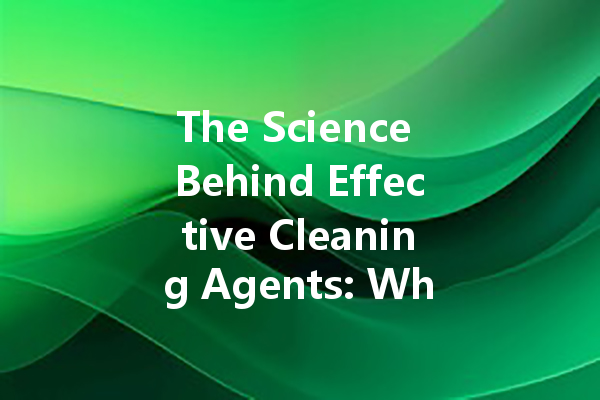Cleaning agents are essential tools in our daily lives, ensuring that our homes, workplaces, and public spaces remain hygienic and pleasant. But what goes into these products, and how do they work effectively to tackle dirt and germs? In this article, we will explore the science behind cleaning agents and their various components, shedding light on how they function and the importance of making informed choices.
洗浄剤を理解する
Cleaning agents, also known as detergents or cleaners, are substances that help remove unwanted dirt, dust, stains, and microbial contaminants from surfaces. They come in various forms, including liquids, powders, gels, and sprays, and are designed for specific cleaning tasks such as laundry, dishwashing, or general household cleaning.
洗浄剤の主成分
界面活性剤
One of the primary ingredients in many cleaning agents is surfactants. These molecules have a unique structure that allows them to interact with both water and oil. The hydrophilic (water-attracting) end binds with water, while the hydrophobic (oil-attracting) end binds with grease and dirt. This dual affinity allows surfactants to break the bond between dirt and surfaces, effectively lifting the grime from the material being cleaned. When water is added, the surfactants reduce the surface tension, enabling the cleaning solution to penetrate and lift dirt more effectively.
酵素
Enzymes are another powerful component often found in cleaning agents, particularly in laundry detergents. These biological molecules act as catalysts to speed up specific chemical reactions, helping to break down complex stains into simpler substances. For example, proteases target protein-based stains like blood or egg, while amylases work on starches. By incorporating enzymes, cleaning agents can enhance their stain-fighting abilities, providing a deeper clean.
溶剤
Solvents, which can be either organic or inorganic, dissolve substances, enhancing the effectiveness of cleaning agents. In all-purpose cleaners or degreasers, solvents help dissolve oils and fats, making removal easier. Common solvents include water, alcohols, and glycol ethers. By understanding the role of solvents, consumers can choose cleaning products that are not only effective but also safe for use around various materials.
洗浄効果におけるpHの役割

酸性およびアルカリ性クリーナー
The pH level of a cleaning agent plays a crucial role in its effectiveness. Cleaning products can be classified as acidic or alkaline, and each serves specific cleaning needs. Alkaline cleaners, which typically have a pH above 7, are excellent for breaking down organic materials and removing grease, making them ideal for kitchen use. Conversely, acidic cleaners, with a pH below 7, are effective against mineral deposits and rust, which is why they’re often used in bathrooms and for cleaning metal surfaces.
Adjusting pH for Performance
Cleaning agents often include pH adjusters to ensure optimal performance under various conditions. For instance, by balancing the pH, manufacturers can enhance the solubility of certain ingredients, improving the overall effectiveness of the クリーナー. Consumers should pay attention to the pH of cleaning products, as using the right formula for the task can significantly impact results.
安全への配慮
Choosing Non-Toxic Ingredients
Increasing awareness of health and environmental concerns has led to a demand for safer, non-toxic cleaning products. Many consumers are now opting for eco-friendly cleaning agents that use plant-based surfactants and biodegradable ingredients. When choosing cleaning products, it’s important to read labels and avoid products containing harsh chemicals like phosphates, chlorine bleach, and synthetic fragrances. These substances can pose health risks and contribute to environmental pollution.
User Safety and Proper Use
It’s essential to follow safety guidelines when using cleaning agents. Many products include safety information on their labels, including proper usage, storage, and what to do in case of accidental contact. Using cleaning agents as directed helps ensure effectiveness while minimizing risks to personal health and the environment.
結論
The science behind effective cleaning agents involves a combination of surfactants, enzymes, solvents, and pH considerations, all working together to tackle dirt and maintain hygiene. By understanding the components that make these products effective, consumers can make informed choices about the cleaning agents they use. Opting for eco-friendly options can provide peace of mind while ensuring your cleaning efforts are both effective and safe for your family and the planet. Whether it’s tackling stubborn stains or maintaining a tidy environment, the right cleaning agent can make all the difference in achieving a clean and healthy space.
